four wheel drive AUDI A8 2014 Owners Manual
[x] Cancel search | Manufacturer: AUDI, Model Year: 2014, Model line: A8, Model: AUDI A8 2014Pages: 314, PDF Size: 78.47 MB
Page 83 of 314
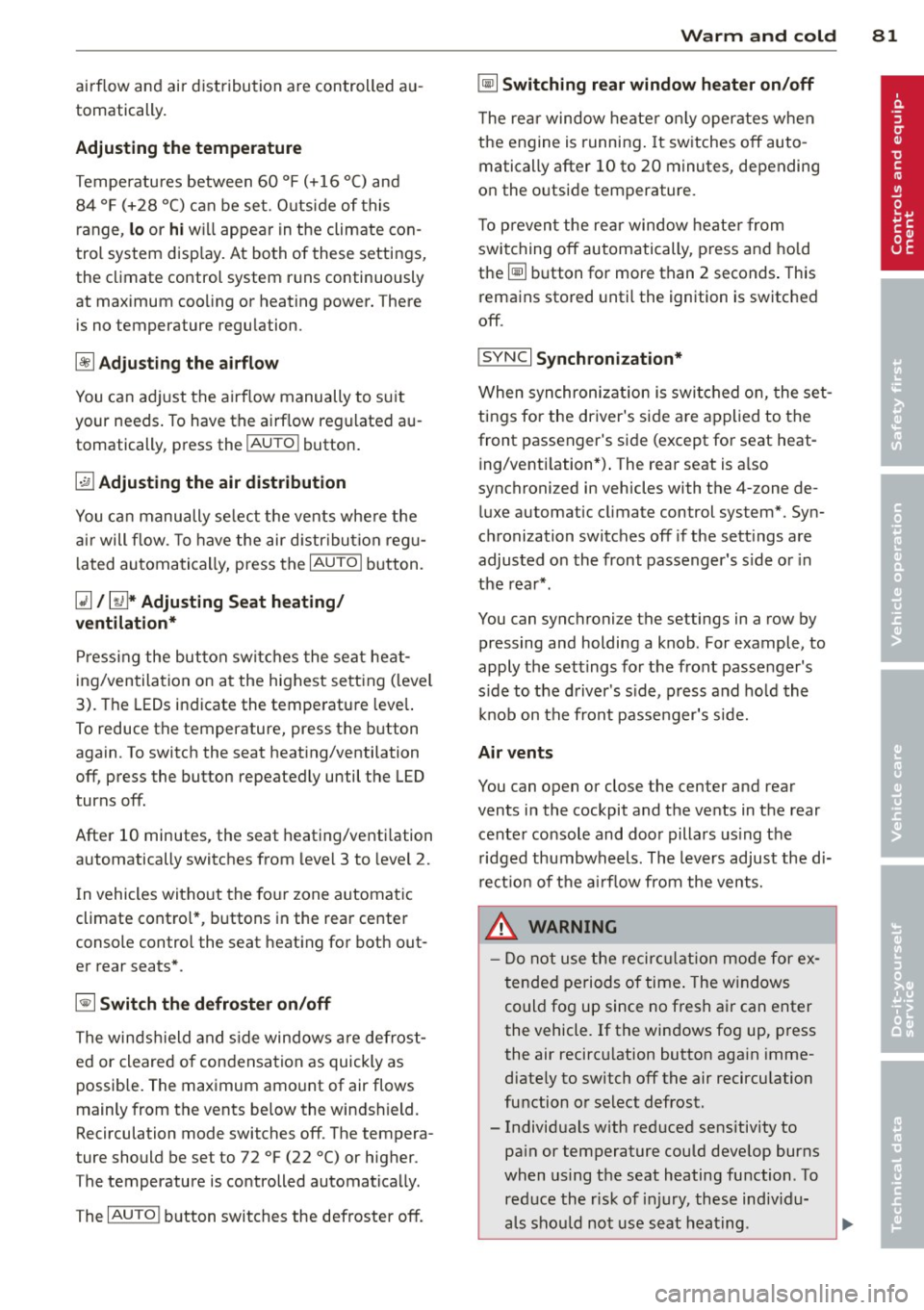
airflow and air distribution are controlled au
tomatically.
Adjusting the temperature
Temperatu res between 60 °F (+16 °() and
84 °F (+28 °C) can be set. O uts ide of this
range,
lo or hi will appear in the climate con
trol system disp lay. At both of these settings,
the climate control system runs continuously
at maximum coo ling or heating power. There
is no temperature regulation.
[!] Adjusting the airflow
You can ad just the airf low manually to suit
your needs . To have the airflow regulated au
tomatically, press the
I AUTO I button.
~ Adjusting the air distribution
You can manually se lect the vents where the
air will flow. To have the air distribution regu
l ated automatically, press the
IAUTOI button.
~ I lil* Adjusting Seat heating/
ventilation*
Pressing the button switches the seat heat
ing/ventilation on at the highest setting ( level
3). The LEDs indicate the temperature leve l.
To reduce the temperature, press the button
again . To switch the seat heating/ventilation
off, press the button repeatedly until the LED
turns off.
After 10 minutes, the seat heating/ventilation
automatically switches from level 3 to level 2.
I n vehicles without the four zone automat ic
climate contro l*, buttons in the rear center
console control the seat heating for both out
er rear seats*.
~ Switch the defroster on/off
The windsh ield and sid e windows are defrost
ed or cleared o f condensation as quickly as
possible. The maximum amount of air flows
mainly from the vents be low the windshield.
Recirculation mode switches off . The tempera
ture should be set to 72 °F (22 °C) or higher.
The temperature is controlled automatically .
The
IAU TOI button switches the defroster off.
Warm and cold 81
~ Switching rear window heater on/off
The rear window heater only operates when
the engine is running. It switches off auto
matically after 10 to 20 minutes, depending
on the outside temperature.
T o p revent the rear window heater from
switching off automatically, press and hold
the ~ button for more than 2 seconds . This
remains stored until the ignition is switched
off .
I SYNC I Synchronization*
When synchronization is switched on, the set
tings for the driver's side are applied to the
front passenger's side (except for seat heat
i ng/venti lation*) . The rear seat is a lso
synchronized in vehicles with the 4-zone de
luxe automatic climate control system* . Syn
chronization switches off if the sett ings are
adjusted on the front passenger's side or in
the rear* .
You can synchronize the settings in a row by
pressing and holding a knob. For example, to
apply the settings for the front passenger's s ide to the driver's side, press and ho ld the
knob on the front passenger's s ide.
Air vents
You can open or close the center and rear
vents in the cockpit and the vents in the rear
center console and door pillars us ing the
ridged thumbwheels. The levers adjust the di
rection of the airflow from the vents.
,&. WARNING
-Do not use the recirc ulation mode for ex
tended periods of time. The windows
could fog up since no fresh air can enter
the vehicle. If the windows fog up, press
the air recircu lation button again imme
diately to switch off the air recirculation
function or select defrost .
- Individuals w ith reduced sensitivity to
pa in or temperature could deve lop burns
when using the seat heating function . To
reduce the risk of injury, these indiv idu-
als shou ld not use seat heating. ..,.
Page 90 of 314

88 On the road
with the footbrake . The parking brake elimi
nates the tendency to creep with a drive range
engaged . As soon as you dr ive off as usual,
the park ing brake is released automatically
and the vehicle starts to move.
Starting on slop es
When starting on inclines, the starting assist
prevents the vehicle from unintentiona lly ro ll
ing back. The braking force of the parking
brake is not released until sufficient driving
force has been bu ilt up at the wheels.
For safety reasons, the park ing brake is re
leased automatically only when the dr iv
er's safety belt is engaged in the buckle.
Starting off with a trailer
To prevent rolling back unintentionally on an
incline, do the following:
.. Keep the switch(®) pulled and depress the
acce lerator. The parking brake stays applied
and prevents the vehicle from ro lling back
ward.
.. You can release the switch (®) once you are
sure that you are develop ing enough for
ward momentum at the wheels as you de
press the accelerator.
Depending on the weight of the r ig (vehicle
and tra iler) and the severity of the incl ine, you
may roll bac kwards as you sta rt. You can pre
vent roll ing backwards by holding the parking
b rake switch (®) p ulled out and acce lerat ing -
just as you would when starting on a hill with a conventional hand brake.
Emergency braking
In the event that the conventional brake sys
tem fails or locks .
.. In an emergency, pull the switch(®) and
contin ue to p ull it t o slow your vehicle down
with the parking brake.
.. As soon as you release the switch (®) or ac
ce lerate, the braking process stops.
If you pull the switch(®) and hold it above a
speed of about 5 mph (8 km/h), the emergen
cy bra king f unct ion is initiated. The vehicle is
braked at all four whee ls by activating the hy
draulic brake system. The brake performance
is simila r to making an emergency stop
c> .&. .
In order not to act ivate the emergency brak
ing by mistake, an audib le warning tone (buz
zer) sounds when the switch(®) is pulled. As
soon as the sw itch (®) is re leased, or the accel
erato r pedal is depressed, eme rgency braking
stops .
.&, WARNING
E mergency braking should only be used in
a n emergen cy, when t he norma l foot bra ke
has fa iled or the brake pedal is obstructed.
Using the par king brake to perform emer
gency b raking will s low your vehicle down
as if you had made a full brake application.
The laws of physics cannot be suspended
even with ESC and its associated compo nents (ABS, ASR, EDL). In corners and
when road o r weathe r cond itions are bad,
a full brake application can cause the v ehi
cle to s kid or the rear end to break away -
r isking an a cci den t.
Start-Stop-System
Description
Appl ies to vehicles : wit h Start-Stop-System
The Start-Stop-System can help increase fuel
economy and reduce CO2 emissions .
In the Start -Stop -mode, the engine shuts off
automat ica lly when the veh icle is stopped,
such as at a traffic light. The ignition remains
switched on during this stop phase. The en
gine wi ll be automat ica lly restarted when
needed .
The last Start-Stop-System setting (on/off us
ing the button
l 0a• I) will be restored when the
ignition is turned on. The LED in the !09 ~1 but
ton turns on when the Start-Stop-System is swit ched off manually.
IJ,,
Page 126 of 314
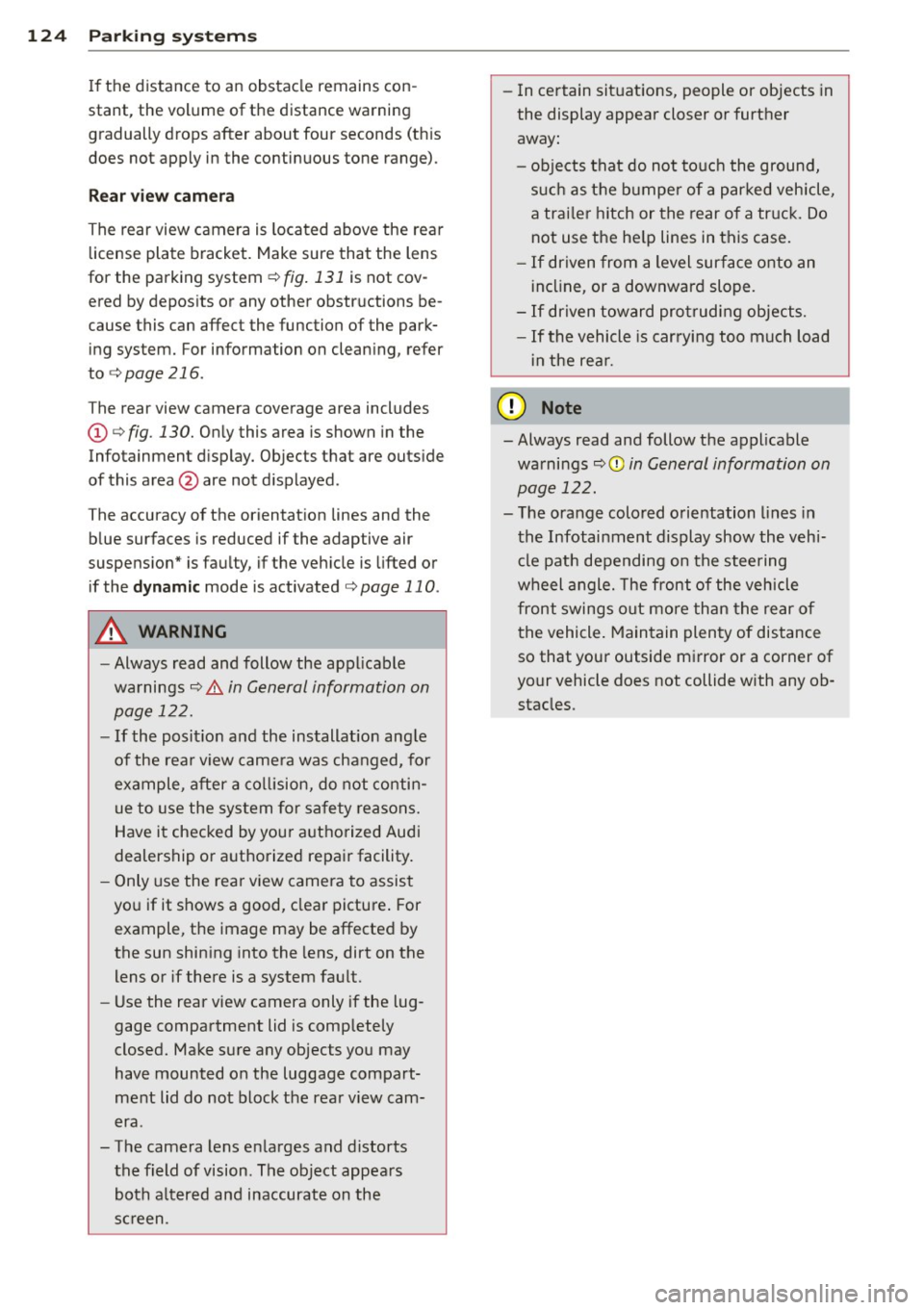
124 Parking systems
If the distance to an obstacle remains con
stant, the volume of the distance warning
gradually drops after about four seconds (this
does not apply in the continuous tone range).
Rear view camera
The rear view camera is located above the rear
license plate bracket. Make sure that the lens
for the parking system¢
fig. 131 is not cov
ered by deposits or any other obstructions be
cause this can affect the function of the park
ing system. For information on cleaning, refer
to
¢ page 216.
The rear view camera coverage area includes
(D ¢ fig. 130. Only this area is shown in the
Infotainment display. Objects that are outside
of this area@are not displayed.
The accuracy of the orientation lines and the blue surfaces is reduced if the adaptive air
suspension" is faulty, if the vehicle is lifted or
if the
dynamic mode is activated¢ page 110.
A WARNING
-Always read and follow the applicable
warnings¢ .&.
in General information on
page 122.
- If the position and the installation angle
of the rear view camera was changed, for
example, after a collision, do not contin
ue to use the system for safety reasons.
Have it checked by your authorized Audi
dealership or authorized repair facility.
- Only use the rear view camera to assist
you if it shows a good, clear picture. For
example, the image may be affected by
the sun shining into the lens, dirt on the
lens or if there is a system fault.
- Use the rear view camera only if the lug
gage compartment lid is completely
closed. Make sure any objects you may
have mounted on the luggage compart
ment lid do not block the rear view cam
era .
- The camera lens enlarges and distorts
the field of vision. The object appears both altered and inaccurate on the
screen. -
In certain situations, people or objects in
the display appear closer or further
away:
- objects that do not touch the ground,
such as the bumper of a parked vehicle,
a trailer hitch or the rear of a truck. Do
not use the help lines in this case.
- If driven from a level surface onto an
incline, or a downward slope.
- If driven toward protruding objects.
-If the vehicle is carrying too much load
in the rear.
{[) Note
-Always read and follow the applicable
warnings
c::> (D in General information on
page 122.
- The orange colored orientation lines in
the Infotainment display show the vehi
cle path depending on the steering
wheel angle. The front of the vehicle
front swings out more than the rear of
the vehicle. Maintain plenty of distance
so that your outside mirror or a corner of
your vehicle does not collide with any ob stacles.
Page 206 of 314
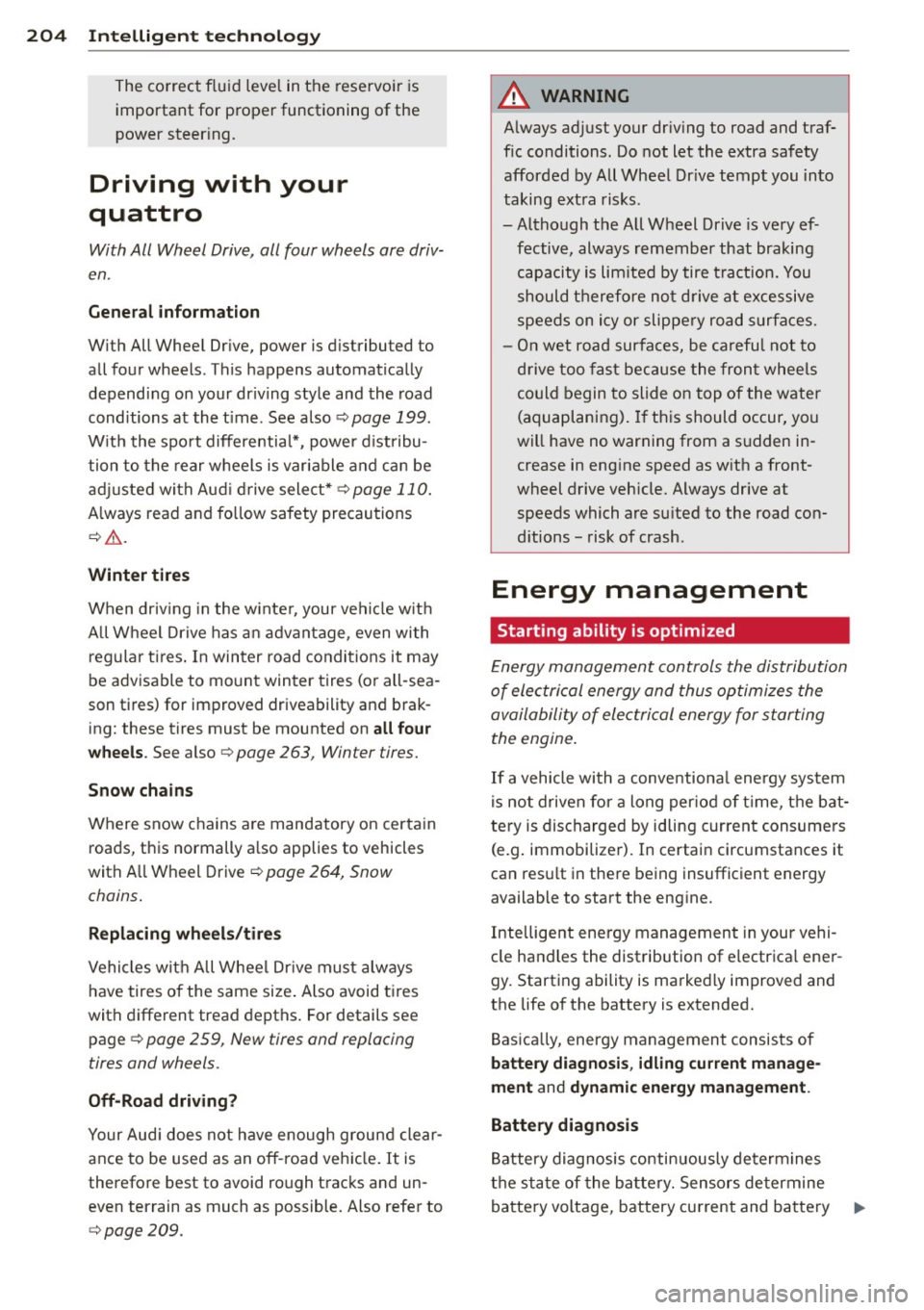
204 Intelligent technology
The correct f luid leve l in the reservoi r is
important for proper functioning of the
power steer ing.
Driving with your
quattro
With All Wheel Drive, all four wheels are driv
en.
General information
With All Wheel Drive, power is distributed to
all four wheels . This happens automatically
depending on your dr iving style and the road
conditions at the t ime . See a lso
c::;, page 199.
W ith the sport differential*, power distribu
tion to the rear wheels is var iable and can be
ad justed with Aud i drive select*
c::;,page 110.
Always read and fo llow safety precautions
¢ &, .
Winter tires
When driv ing in the w inter, your vehicle w ith
A ll Wheel Drive has an advantage, even with
r egular tires. In winter road conditions it may
be advisable to mount winter tires (or all-sea
son tires) for improved driveability and brak ing: these tires must be mounted on all four
wheels. See also c:;, page 263, Winter tires.
Snow chains
Where snow chains are mandatory on certain
roads, this normally a lso applies to vehicles
with A ll Wheel Drive
¢ page 264, Snow
chains.
Replacing wheels/tires
Vehicles with A ll Wheel Dr ive must always
have tires of the same size . Also avoid ti res
with different tread depths. For details see
page
c:;, page 2 59, New tires and replacing
tires and wheels.
Off-Road driving?
Your Aud i does not have enough ground clear
ance to be used as an off -road vehicle. It is
therefore best to avoid rough tracks and un
even terrain as much as possible. Also refer to
c::;, page209.
A WARNING
Always adjust your driving to road and traf
f ic conditions. Do not let the extra safety
afforded by All Wheel Drive tempt you into
taking extra risks.
- Although the All Wheel Drive is very ef
fective, always remember that braking
capacity is lim ited by tire traction. You
should therefore not drive at excessive
speeds on icy or slippery road surfaces.
- On wet road surfaces, be careful not to
drive too fast because the front wheels
could begin to slide on top of the water
(aquaplaning) . If this should occur, you
will have no warning from a sudden in
crease in eng ine speed as with a front
wheel drive vehicle. Always drive at speeds which are suited to the road con
ditions - risk of crash.
Energy management
Starting ability is optimized
Energy management controls the distribution
of electrical energy and thus optimizes the
availability of electrical energy for starting
the engine .
If
a vehicle with a conventiona l ene rgy system
is not driven for a long period of time, the bat
tery is discharged by idling current consumers
(e .g . immobilizer). In certain circumstances it
can resu lt in there being insufficient energy
available to start the engine .
Intelligent energy management in your vehi
cle handles the distribution of e lectrica l ener
gy. Starting ability is markedly improved and
the life of the battery is extended.
Basically, energy management consists of
battery diagnosis , idling current manage
ment
and dynamic energy management.
Battery diagnosis
Battery diagnosis continuously determines
the state of the battery. Sensors determine
battery voltage, battery current and battery ..,.
Page 253 of 314
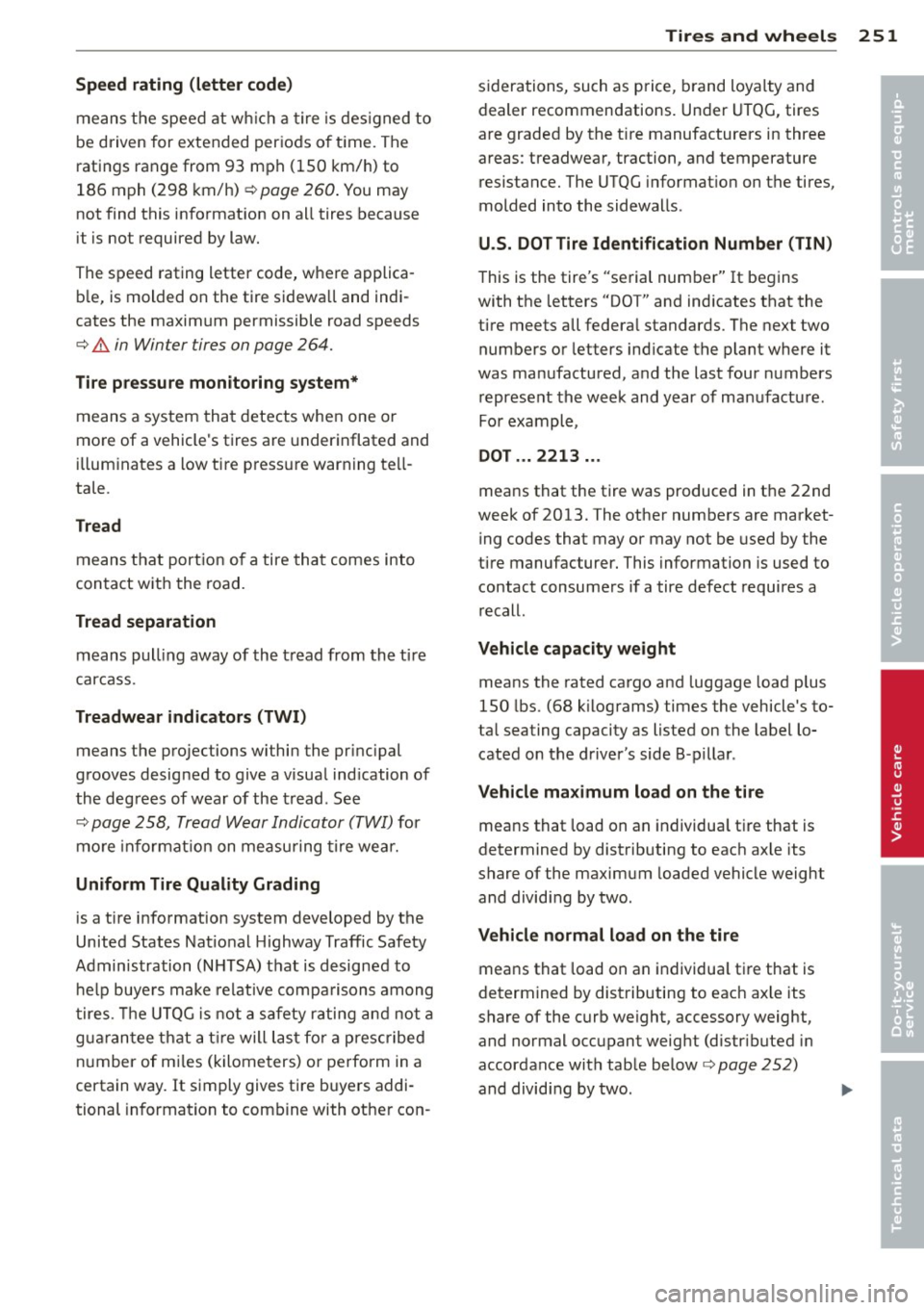
Speed rating (letter code)
means the speed at wh ich a tire is des igned to
be driven for extended periods of t ime . The
ratings range from 93 mph (150 km/h) to
186 mph (298 km/h) ¢
page 260 . You may
not find this information on all tires because
it is not required by law.
The speed rating letter code, where applica ble, is molded on the tire sidewall and indi
cates the maximum permissible road speeds
¢ &. in Winter tires on page 264.
Tire pressure monitoring system*
means a system that detects when one or
more of a vehicle's tires are underinflated and
illuminates a low tire pressure warn ing te ll
tale .
Tread
means that port ion of a tire that comes into
contact with the road.
Tread separation
means pulling away of the tread from the tire
carcass .
Treadwear indicators (TWI)
means the projections within the pr incipal
grooves designed to give a visual ind ication of
the degrees of wear of the tread. See
¢
page 258, Tread Wear Indicator (TWI) for
mo re inf ormat ion on measuring tire wear.
Uniform Tire Quality Grading
is a tire information system developed by the
United States National Highway Traffic Safety
Admin istration (N HTSA) that is designed to
help buyers make relative comparisons among
tires . Th e U TQG is not a safety rating and not a
g ua ran tee that a tir e will last for a prescribed
number of mi les (kilometers) or perform in a
certain way.
It simply gives tire buyers addi
tional information to combine with other con-
Tires and wheels 251
siderations, such as price, brand loyalty and
dealer recommendations. Under UTQG, tires
are graded by the t ire manufacturers in three
areas : treadwear, traction, and temperature
resistance. The UTQG informat ion on the tires,
molded into the sidewalls .
U.S. DOT Tire Identification Number (TIN)
This is the tire's "serial number" It begins
with the letters "DOT" and indicates that the
tire meets all federa l standards. The next two
numbers or letters indicate the plant where it
was manufactured, and the last four numbers
represent the week and year of manufacture.
For example,
DOT ... 2213 ...
means that the tire was produced in the 22nd
week of 2013. The other numbers are market
ing codes that may or may not be used by the
tire manufacturer. This information is used to
contact consumers if a tire defect requires a
recall.
Vehicle capacity weight
means the rated cargo and luggage load plus
150 lbs. (68 k ilograms) times the vehicle's to
tal seating capacity as listed on the label lo
cated on the driver's side B -pillar .
Vehicle maximum load on the tire
means that load on an individual tire that is
determined by distributing to each axle its
share of the maximum loaded vehicle weight
and dividing by two.
Vehicle normal load on the tire
means that load on an individual tire that is
determined by distributing to each ax le its
share of the curb weight, accessory weight,
and normal occupant weight (distr ibuted in
accordance with table below¢
page 252)
and dividing by two.
•
•
Page 260 of 314
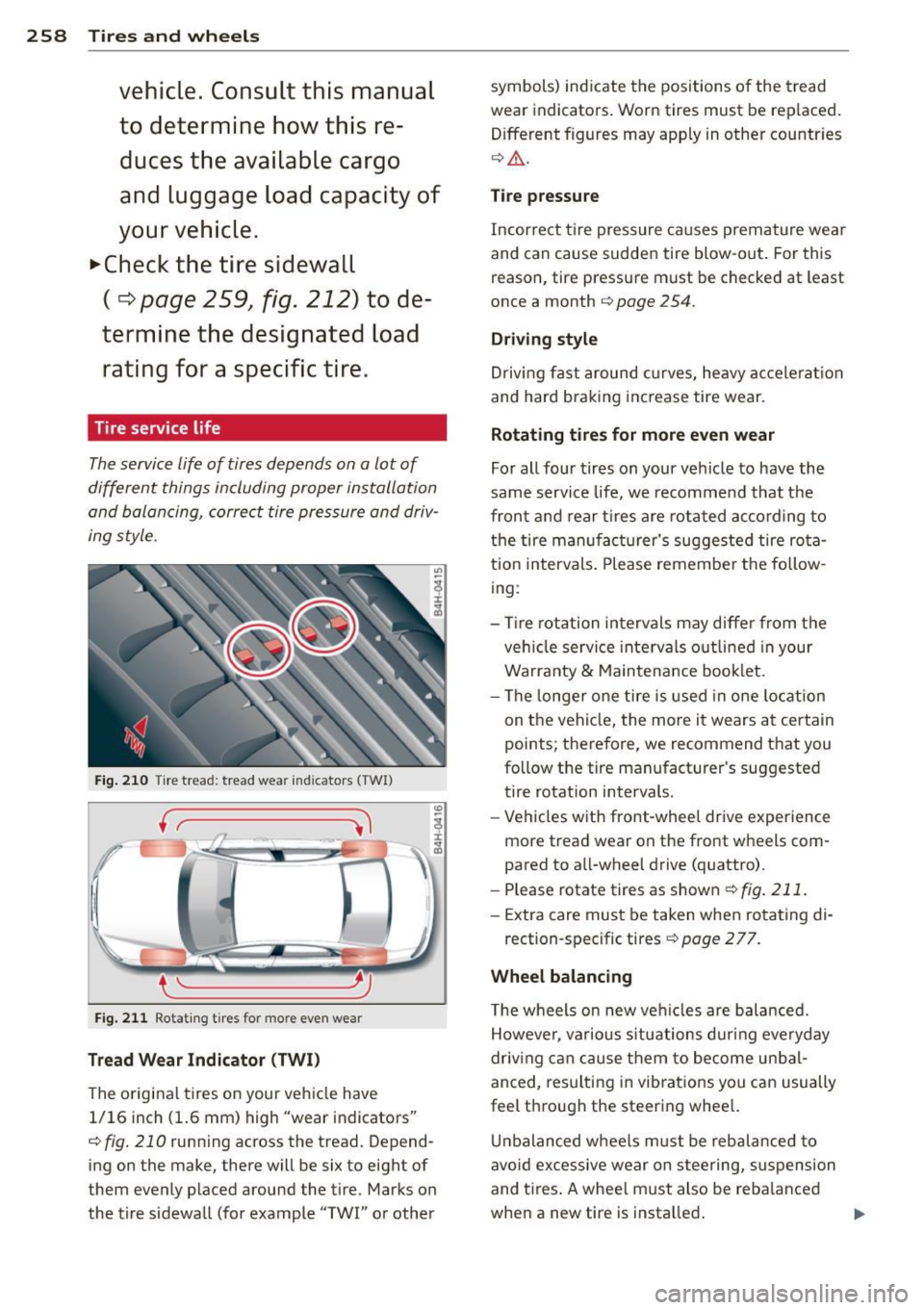
258 Tires and wheels
ve hi cle. C onsult thi s m anual
t o deter mine how this re
d uce s the availabl e cargo
a nd lug gage lo ad ca pacity of
yo ur vehicle .
.,.Che ck the tire sidewall
(¢ page 259 , fig . 212 ) to de
termine the de signa ted lo ad
rating for a specific tire .
Tire service life
The service life of tires depends on a lot of
different things including proper installation
a nd balan cing, correct tire pressure and driv
ing style.
Fig . 210 Tire tread: tread wea r ind icato rs (TWI)
( r------
{ \.._ ______ _.
F ig. 211 Rotat ing t ires for more even wear
Tread Wear Indicator (TWI)
The o rigina l tires on your veh icle have
1/16 inch (1.6 mm) high "wear indicators"
c:::> fig . 210 running across the tread. Depend
ing on the make, there will be six to eight of
them evenly p laced around the t ire . Marks on
the tire s idewall (for example
"TWI" or other symbols) ind
icate the positions o f the tread
wear indicato rs . Worn tires must be replaced .
Different figures may app ly in other countr ies
¢ Ll:). .
Tire pressur e
Incorrect t ire pressure ca uses prema ture wear
and can cause sudden tire blow -out . For this
reason, tire pressure must be checked at least
once a month
c:::> page 254.
Driving style
Dr iving fast around c urve s, he avy a ccele rat ion
and hard braking inc rease tire wear.
Rotating tires for more even wear
Fo r all four tires on your veh icle to have th e
same service life, we recomme nd that the
fron t and rear tires a re rotated ac co rd ing to
the tire m an ufa ctu rer's suggested tire ro ta
tion intervals . Please remembe r th e fo llow
ing :
- Tire rotation in tervals may diffe r from the
ve hicle service inte rva ls o utlin ed in your
Warranty
& M aintena nce booklet.
- The longe r one tire is used in one lo cation
on t he veh icle, the more it wears at cer tain
points; there fore, we recommend that you
follow the tire manufact urer's suggested
tire rotation intervals.
- Vehicles w ith front-whee l dr ive experience
more tread wear on the front w heels com
pa red to a ll-wheel drive (q uattro).
- Please rotate tires as shown
c:::>fig . 211.
- Extra care mus t be taken when ro ta ting di-
rection-specific tires¢
page 2 77.
Wheel balancing
The wheels on new ve hicles are balanced.
However, va rious s ituatio ns dur ing everyday
driv ing c an cause them to become unbal
anced, res ulting in vib rations you can usually
feel thro ugh the steering whee l.
Un balanced w hee ls mu st be rebalanced to
avo id excessive wear on steering, s uspension
and t ires . A whee l m ust also be reba lance d
when a new tire is insta lled .
ll-
Page 264 of 314
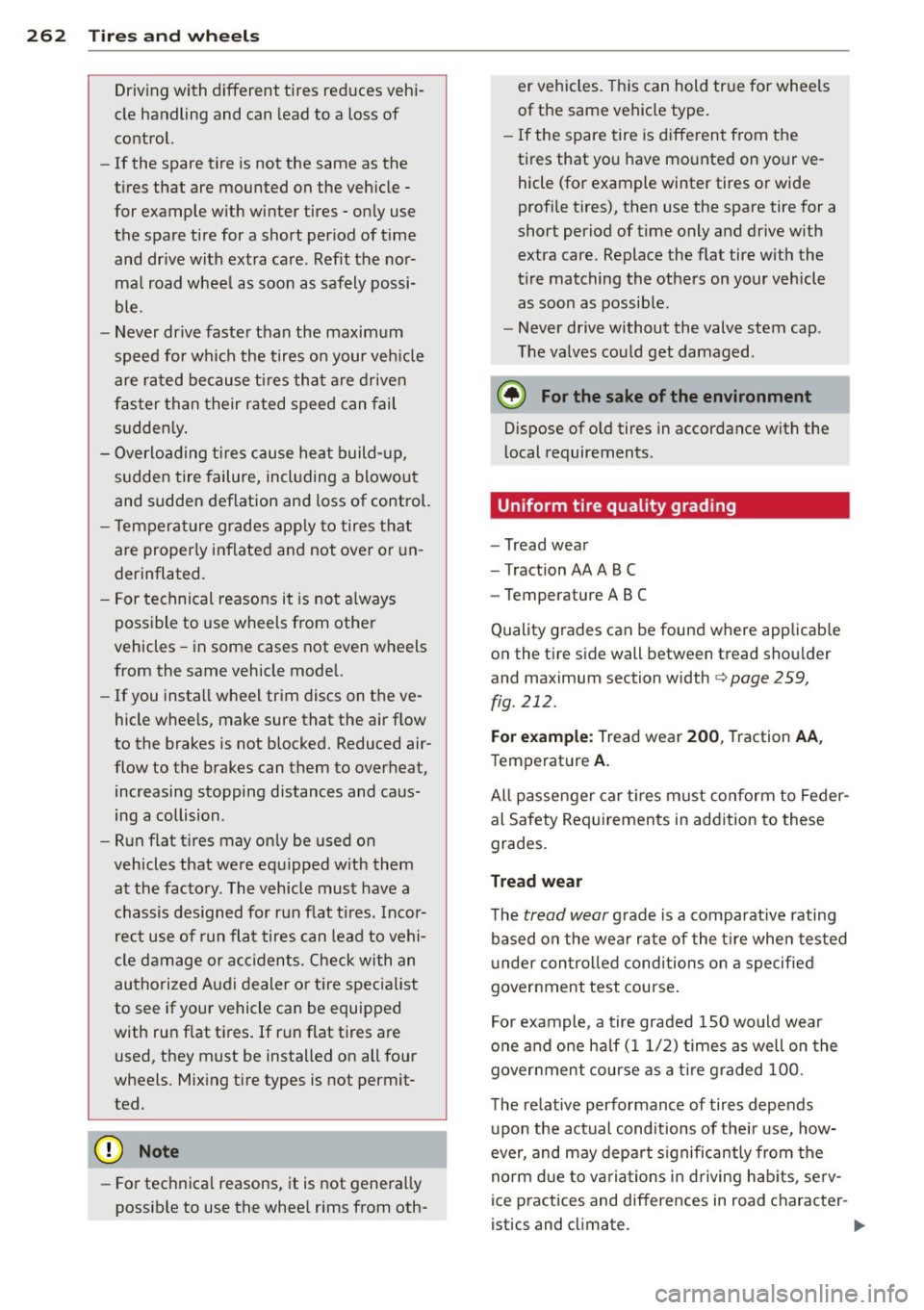
26 2 T ire s and wheel s
Driving with different tires reduces vehi
cle handling and can lead to a loss of
co ntrol.
- I f the spare tire is not the same as the
t ires that are mounted on the veh icle -
for example with winter tires - only use
the spare tire for a short period of time
and dr ive with extra care . Refit the nor
ma l road wheel as soon as safely possi
ble.
- Never drive faste r than the maximum
speed for which the tires on your veh icle
are rated because ti res that a re driven
faster than their rated speed can fail
sudden ly .
- Overloading t ires cause heat build- up,
sudden tire failure, including a blowout
and sudden deflation and loss of control.
- T emperature grades app ly to tires that
are properly inflated and not over o r un
derinflated .
- For technical reasons it is not a lways
possible to use wheels from other
vehicles -in some cases not even wheels
from the same vehicle model.
- If you insta ll wheel trim discs on the ve
hicle whee ls, make sure that the air f low
to the brakes is not blocked. Reduced air
flow to the brakes can them to overheat, increasing stopping distances and caus
ing a collision .
- Run flat t ires may on ly be used on
vehicles that were equ ipped w ith them
at the facto ry . The vehicle must have a
chassis des igned for run f lat t ires . Incor
rect use of run flat tires can lead to vehi
cle damage or acc idents. Check with an
au thorized Aud i dealer or ti re specia list
to see if your vehicle can be equipped
with run f lat tires. If run flat tires are
used, they must be installed on all four
wheels . Mix ing tire types is not permit
ted .
(D Note
-For technica l reasons, it is not generally
possib le to use the whee l rims from oth- er veh
icles. This can hold true for wheels
of the same vehicle type.
- If the spare tire is d iffe rent from the
tires that yo u have mounted on your ve
hicle (for example winter tires o r wide
profi le tires), then use the spare tire for a
short period of time only and drive w ith
extra care. Replace the flat tire w ith the
tire matching the others on your vehicle as soon as possible .
- Never drive without the valve stem cap .
T he valves could get damaged .
® For the sake of the environment
Dispose of o ld tires in accordance with the
l ocal requirements.
Uniform tire quality grading
- Tread wear
- Traction AA A B C
- Temperature ABC
Quality grades can be found where applicab le
on the t ire s ide wall between tread shou lder
and maximum section width
c> page 259,
fig. 212 .
For example : Tread wear 200, Traction AA,
Temperature A.
All passenger ca r tires must conform to Feder
al Safety Requirements in addition to these
grades.
Tread wear
T he tread wear grade is a comparative rating
based on the wear rate of the t ire when tested
u nder contro lled conditions o n a specified
government test course .
For example, a tire graded 1S0 would wear
one and o ne ha lf ( 11/2) times as well on the
gover nment course as a t ire g raded 100 .
The relative performance of tires depends upon the actual conditions of their use, how
ever, and may depa rt s ignificantly from the
norm due to va ria tions in d riving hab its, se rv
ice practices and differences in road character-
istics and climate.
ll-
Page 265 of 314
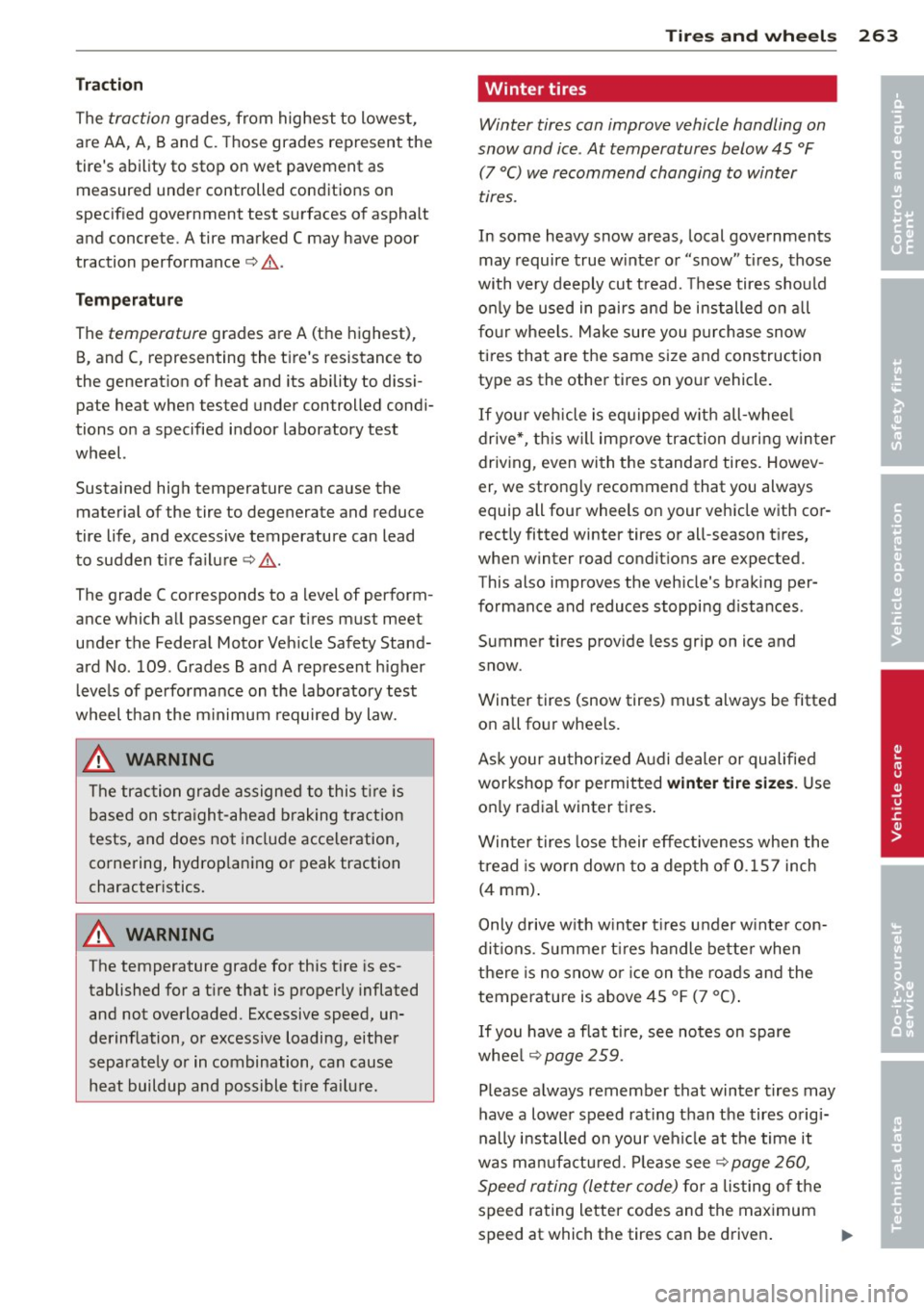
Traction
The traction grades, from highest to lowest,
a re AA, A, Band
C. Those grades represent the
tire's ability to stop on wet pavement as
measured under controlled conditions on
specified government test surfaces of asphalt
and concrete . A tire marked C may have poor
traction performance¢ .&..
Temp eratu re
The temperature grades are A (the highest),
B, and
C, representing the tire 's resistance to
the generat ion of heat and its ability to dissi
pate heat when tested under controlled condi
tions on a specified indoor laboratory test
wheel.
Sustained high temperature can cause the
material of the tire to degenerate and reduce
tire life, and excessive temperature can lead
to sudden tire failu re ¢ .&. .
The grade C corresponds to a level of perform
ance which all passenger car tires m ust meet
u nder the Federa l Motor Ve hicle Safety Stand
ard No.
1 09. Grades Band A represent higher
l eve ls of pe rformance on the laboratory test
wheel than the m inimum required by law.
_& WARNING
Th e traction grade assigned to this tire is
based on stra ight-ahead b raking t raction
tests, and does not include acceleration,
cornering , hydrop laning or peak traction
character istics.
A WARNING
The temperature grade for this t ire is es
tablished for a t ire that is properly inflated
and not overloaded. Excessive speed, un
derinflation, or excessive loading, either
separate ly or in combination, can cause
heat buildup and possibl e tire fa ilu re.
-
Tire s an d wheel s 263
Winter tires
Winter tires can improve vehicle handling on
snow and ice . At temperatures below 45 °F
(7 °C) we recommend changing to winter
tires.
In some heavy snow areas, local governments
may require true w inter o r "snow" tir es, those
with very deeply cut t read. These tires should
o nl y be used in pairs and be installed o n all
f o ur wheels . Make sure you p urchase snow
ti res that are the same size and cons truc tion
type as the other tires on yo ur vehicle .
I f your veh icle is eq uipped w ith all-whee l
drive *, t his w ill improve trac tion durin g w in ter
driv ing, even wi th the s tanda rd tires. Howev
er, we strongly recommend that you always
equip all four wheels on your veh icle w ith cor
rect ly fitted winter tires or all-season t ires,
when winter road condit ions are expected.
This also improves the veh icle 's b rak ing per
fo rmance and reduces stoppi ng d ista nces .
Summer tires provide less grip on ice and
snow.
Winter tires (snow tires) must always be fitted
o n all fo ur whee ls .
As k your au thori zed A udi d ealer or qualified
workshop for permit ted
winter tire size s. Use
o nl y radial winter ti res .
Win ter tires lose their effec tiveness whe n the
tread is worn down to a depth o f
0.15 7 inch
(4 mm) .
Only d rive w it h w inte r tir es under w inte r con
di tions. S umme r tir es handle bette r whe n
t h e re is no s now o r ice on the ro ad s an d the
temperature is above 45 ° F (7 °C) .
I f you have a flat t ire, see notes on spare
whee l
¢page 259.
Please a lways remember that winter tires may
have a lowe r sp eed rating than the tires o rig i
nally i nstalled on your veh icle at t he time it
was ma nufactu red. Please see ¢
page 260,
Speed ra ting (letter code)
for a lis ting o f th e
speed ra ting lette r codes and the max imum
speed at which the tires can be driven .
111>-
•
•
Page 269 of 314
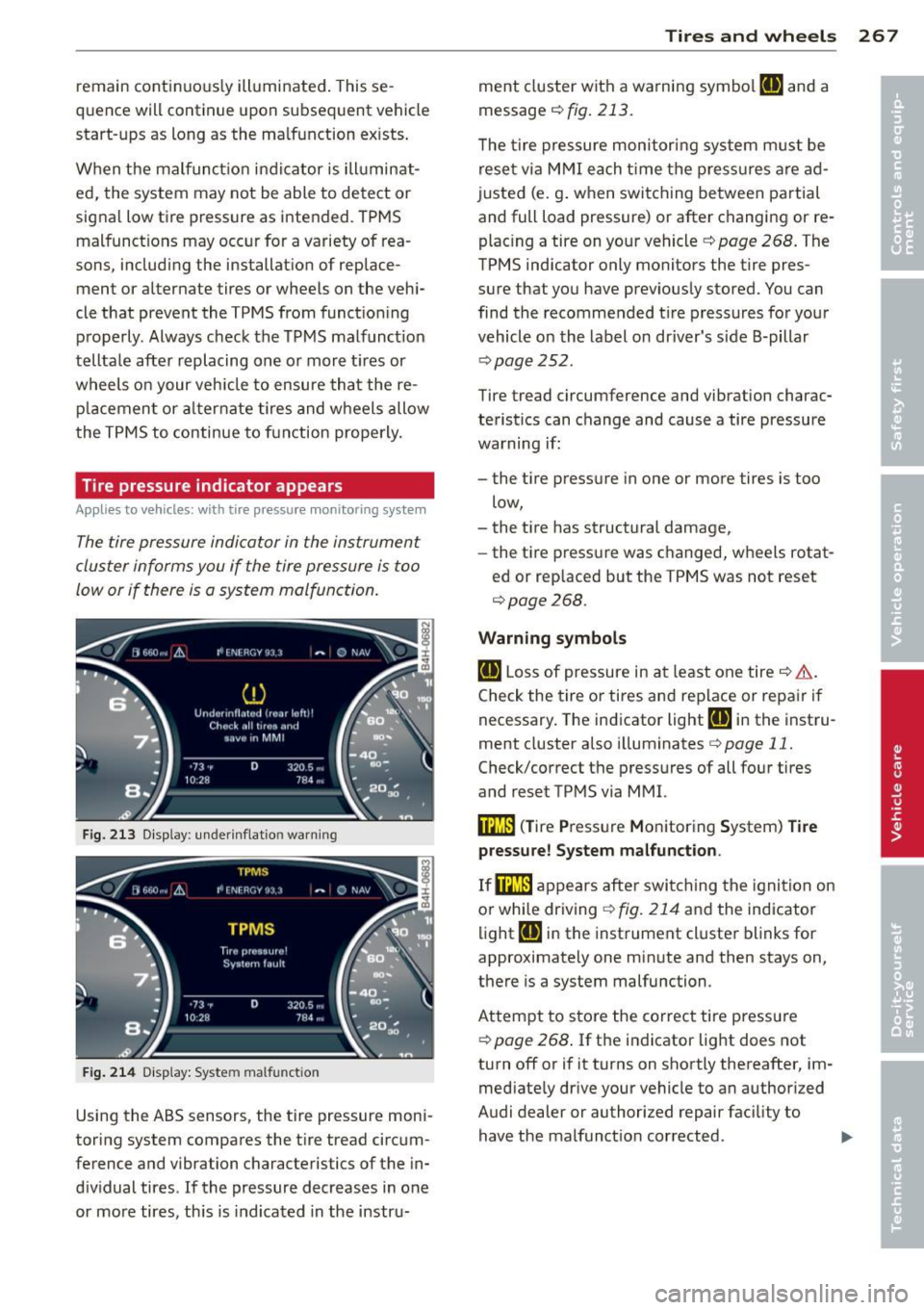
remain continuously illuminated. This se
quence will continue upon subsequent vehicle
start-ups as long as the malfunction exists.
When the malfunction indicator is illuminat
ed, the system may not be able to detect or
signal low tire pressure as intend ed . TPMS
malfunctions may occur for a variety of rea
sons, including the installation of replace
ment or alternate tires or wheels on the vehi
cle that prevent the TPMS from functioning
properly . Always check the TPMS malfunction
telltale after replacing one or more tires or
wheels on your vehicle to ensure that the re
placement or alternate tires and wheels allow
the TPMS to continue to function properly.
Tire pressure indicator appears
Applies to vehicles: with tire pressure monitoring system
The tire pressure indicator in the instrument
cluster informs you if the tire pressure is too
low or if there is a system malfunction.
Fig. 213 Display : underi nflatio n warning
Fig. 214 Di splay: Syste m mal functio n
Using the ABS sensors, the tire pressure moni
toring system compares the tire tread circum
ference and vibration ch arac teristics of the in
dividual tires. If the pressure decreases in one
or more tires, this is indicated in the instru-
Tires and wheels 267
ment cluster with a warning symbol [I] and a
message
r::!) fig. 213.
The tire pressure monitoring system must be
reset via MMI each time the pressures are ad
justed (e.g. when switching between partial
and full load pressure) or after changing or re
placing a tire on your vehicle
r::!) pag e 268. The
TPMS indicator only monitors the tire pres
sure that you have previously stored. You can
find the recommended tire pressures for your
vehicle on the label on driver's side 8-pillar
<=:>page 252 .
Tire tread circumference and vibration charac
teristics can change and cause a tire pressure
warning if:
- the tire pressure in one or more tires is too
low,
- the tire has structural damage,
- the tire pressure was changed, wheels rotat-
ed or replaced but the TPMS was not reset
r::!) page 268 .
Warning symbols
[I] Loss of pressure in at least one tire q &..
Check the tire or tires and replace or repair if
necessary. The indicator light
[I] in the instru
ment cluster also illuminates
¢page 11.
Check/correct the pressures of all four tires
and reset TPMS via MMI.
i:mJ) (Tire Pressure Monitoring System) Tire
pressure! System malfunction .
If@m appears after switching the ignition on
or while driving
q fig. 214 and the indicator
light
[I] in the instrument cluster blinks for
approximately one minute and then stays on,
there is a system malfunction .
Attempt to store the correct tire pressure
¢ page 268. If the indicator light does not
turn off or if it turns on shortly thereafter, im
mediately drive your vehicle to an authorized
Audi dealer or authorized repair facility to
have the malfunction corrected .
Page 275 of 314

-Always store the vehicle tool ki t, the jack
and t he replaced t ire in the luggage com
partment ¢
page 141 .
@ Tips
Before chang ing the wheel, you must acti
vate the jacking mode, so that the auto
mat ic controls for the Adaptive Air Sus
pens ion do not make it more difficu lt to
lift the vehicle with the jack¢
page 2 75.
Changing a wheel
When you change a wheel, follow these
quence described below step-by-step and in
exactly that order .
1. Activate the vehicle jack mode
c:;.page275.
2. Remove the decorative whe el co ver* . For
mo re deta ils see also
c:;, page 2 73, Deco
rative wheel covers
or c:;, page 2 7 4,
Wheels with wheel bolt caps.
3 . Loosen the wheel bo lts c:;, page 2 7 4.
4. Locate the proper mo unt ing po int for the
jack and align the jack below that point
c:;, page 2 75.
5 . Rai se the car w ith the jack c:;, page 275.
6. Remove the wheel with the flat tire and
then install
the spare c:;, page 2 76 .
7. Tighten all wheel bo lts light ly .
8 .
Lower the ve hicle w it h the jack.
9 . Use t he wheel bolt wre nch and
firmly
tighte n all whee l bolts c:;. page 274.
10. Rep lace the de corative wheel cover* .
11. D eactivate the vehicle jack mode in t he
MMI:
! CARI fu nction button > Car system s
control button > Servicing & che cks > Air
susp.: jack mode > Off .
The vehicle jack mode sw itches off automati
cally at speeds above 10 km/h.
A WARNING
Always read and follow all WARNINGS and
information
c:;, .&. in Raising the vehicle on
page 275
and c:;, page 277.
What do I d o now ? 273
After changing a wheel
A wheel change is not complete without the
doing the following.
.,. Always store the vehicle tool kit, the jack*
and the replaced tire in the luggage com
partment
c:;, page 141 .
.,. Check the tire pressure on the spare whee l
immed iate ly afte r mounting i t.
.,. As soon as poss ib le, have the
tight ening
torque s
on all wheel bolts checked w ith a
torque wrenc h. The co rrec t tighten ing tor
que is 90 ft lb (120 Nm).
.,. Have the flat tire
replaced as soon as possi
ble .
@ Tips
-If you notice that the wheel bo lts a re
corroded and difficult to turn while
chang ing a tire, they should be replaced
before you c heck the tightening torque.
- Drive at reduced speed until you have the tightening torques checked .
- After changing a whee l, the ti re press ure
in all four tires must be checked/correct
ed and the tire press ure monitoring ind i
cator must be sto red in the M MI
c:;. page268 .
Decorative wheel covers
Applies to veh icles: w ith decorative w hee l cove rs
The decorative wheel covers mus t be removed
first to access the wheel bolts.
Fi g. 22 1 Chang ing a whee l: Re moving th e w hee l cover
Removing
.,. Insert the hook (provided with the vehicle
t oo l kit) in the ho le in the whee l hub cover .
i,,.